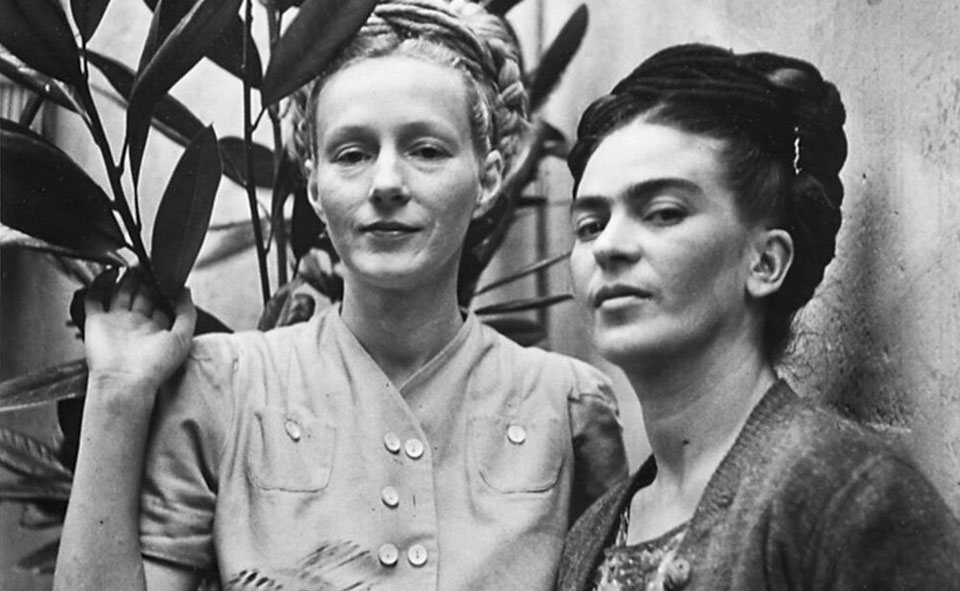
RICHMOND, Calif. — Emmy Lou Packard: Artist of Conscience is a stunning, if overdue, retrospective exhibition of an artist largely ignored in her lifetime by critics—even though she worked directly with Diego Rivera, mentoring and inspiring a generation of Bay Area muralists in her late years. She died in 1998 at age 83.
A southern California native whose father worked as an agronomist for a time in Mexico, Packard began studying with Rivera at age 12. She later lived with Rivera and Frida Kahlo in Mexico after her husband’s tragic death and became the muralist’s principal assistant on the Pan American Unity mural for the 1940 Golden Gate International Exposition on Treasure Island. On loan from City College of San Francisco, the mural is currently on display at SFMOMA, with Packard among those depicted in it.

The visually striking, morale-boosting exhibit at the Richmond Art Center couldn’t be timelier, not only with a newly opened Rivera retrospective at SFMOMA but for the powerful way in which it reasserts progressive values. Working at Kaiser Shipyard’s newspaper Fore ‘n’ Aft in Richmond during World War II, Packard created illustrations calling for racial unity and for workers to exercise their right and responsibility to vote. Other, larger black-and-white linocut prints portray a resolute Frederick Douglass and a satirically reimagined George Washington held by two G-men for his embrace of the Constitution and the Declaration of Independence. The latter print is captioned: “We’ve discovered that this guy was an insurgent leader, Boss—What’ll we do now?!” These images show Packard pushing back against racial tensions at wartime defense plants and the repression of civil liberties.
A mixed-media linocut collage titled “Someone Has to Suffer, Madam” portrays a businessman with a pig’s head, meaty left hand outstretched, war contracts in his back pocket, and right arm encircling the shoulders of a grief-stricken woman. The political cartoon, made in the 1950s, incorporates a torn newspaper clipping headlined: “Stock Market Dive Worst in 18 Months” with a subhead, “Worries Outweigh Cease-Fire,” adjacent to another article titled “Peace News and Market.” It sharply underscores the still-present contradiction of a bullish stock market juxtaposed against the toll of human sacrifice and suffering. Rivera and Kahlo astutely dubbed their fragile-looking guest “Emmy Lucha,” Spanish for fight. (She also led the fight to save Mendocino Headlands, now a state park.)

The heart of the show lies in Packard’s large, bold, colorful, and technically masterful prints showing strawberry pickers, artichoke harvesters, crab fishermen, welders, Italian and Chinese produce market vendors—all evoking California’s people and the land. In “Net Menders,” for example, we see curvilinear, whiplash-like lines juxtaposed against delicate, broken-line patterning and strong hands. Swirling clouds above foreshortened row crops dwarf a Lilliputian field crew in “Landscape Near Half Moon Bay,” while “Merry-Go-Round” pictures a multi-racial group of kids, limbs flung akimbo. Together, the 78 works on view express joy, exuberance, anger, and fulfillment in natural settings that frame human efforts. We also see the waste of war. “Peace is a Human Right” (1949) shows three children with a sunflower and dove, an iconic image during the Vietnam War that sadly speaks to the present moment.
The exhibit, three years in the making by curators Robbin Légère Henderson and Rick Tejada-Flores, is supported by an informative, beautifully illustrated brochure in which they ask: “Why has this powerful artist been so overlooked?” The answer lies partly in the political, cultural, and visual art landscape in the U.S. following World War II, shifting away from the Social Realism of the New Deal toward Abstract Expressionism. After the war, most art critics tended to disparage or ignore figurative, socially expressive work by left-wing artists in the U.S. who were sympathetic to working people; these included Ben Shahn, Jacob Lawrence, and Alice Neel (whose work is currently on display at the de Young Museum), as well as Rivera.

In addition to changing aesthetic preferences, women were displaced from the workplace, forced to leave the male-gendered jobs they occupied during the war, as veterans came home to reclaim their work. Women weren’t expected to compete, “even in the arts,” note the curators. “Packard’s gender, her politics, the genre she chose and the era she lived in combined to exclude her from serious consideration by guardians of public taste.”
Tejada-Flores, a documentary filmmaker exploring art and politics, met Packard as an art student in 1963 and accepted an invitation to print graphics for her at the gallery in Mendocino. He became a lifelong friend. He and Robbins, a former art museum director and curator whose own prints champion labor organizing, teamed to gather the generous assemblage of drawings, prints, photos, and ephemera on loan from a long list of institutional and private collections (including their own).

Packard’s “artistic mastery and commitment to peace and justice inspired admiration and activism” in her late years, note the curators, including that of San Francisco artist Susan Cervantes, founder of Precita Eyes Muralists Association and the Latinx women of Mujeres Muralistas, who painted the gorgeous, larger-than-life murals on the Women’s Building in the mid-1990s.
Absent the critical recognition withheld in her lifetime, it’s rewarding that this show resonates loudly. Packard’s art of conscience calls to us still: to recognize the worth of laborers, realize inclusiveness, ignite solidarity, appreciate the bountiful harvests of California’s coast and fields, and celebrate the natural beauty of the land.
Emmy Lou Packard: Artist of Conscience is on view at the Richmond Art Center through August 20. A film screening of Rivera in America, in which she is interviewed, is scheduled for August 11.
Reposted in People’s World by permission of the author and publisher. This review originally appeared in Square Cylinder Northern California, July 21, 2022, and can be viewed here.

MOST POPULAR TODAY

High Court essentially bans demonstrations, freedom of assembly in Deep South

Zionist organizations leading campaign to stop ceasefire resolutions in D.C. area

U.S. imperialism’s ‘ironclad’ support for Israel increases fascist danger at home

UN warns that Israel is still blocking humanitarian aid to Gaza







Comments